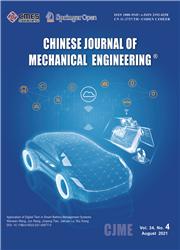Dynamic Recrystallization Behavior of Q370qE Bridge Steel
IF 4.5
2区 工程技术
Q1 Engineering
引用次数: 0
Abstract
Abstract Bridge steel has been widely used in recent years for its excellent performance. Understanding the high-temperature Dynamic Recrystallization (DRX) behavior of high-performance bridge steel plays an important role in guiding the thermomechanical processing process. In the present study, the hot deformation behavior of Q370qE bridge steel was investigated by hot compression tests conducted on a Gleeble 3800-GTC thermal-mechanical physical simulation system at temperatures ranging from 900 ℃ to 1100 ℃ and strain rates ranging from 0.01 s −1 to 10 s −1 . The obtained results were used to plot the true stress-strain and work-hardening rate curves of the experimental steel, with the latter curves used to determine the critical strains for the initiation of DRX. The Zener-Hollomon equation was subsequently applied to establish the correspondence between temperature and strain rate during the high-temperature plastic deformation of bridge steel. In terms of the DRX volume fraction solution, a new method for establishing DRX volume fraction was proposed based on two theoretical models. The good weathering and corrosion resistance of bridge steel lead to difficulties in microstructure etching. To solve this, the MTEX technology was used to further develop EBSD data to characterize the original microstructure of Q370qE bridge steel. This paper lays the theoretical foundation for studying the DRX behavior of Q370qE bridge steel.Q370qE桥梁钢的动态再结晶行为
摘要桥梁钢以其优异的性能,近年来得到了广泛的应用。了解高性能桥梁钢的高温动态再结晶(DRX)行为对指导热机械加工具有重要意义。在Gleeble 3800-GTC热力学物理模拟系统上,对Q370qE桥钢在900 ~ 1100℃温度范围内、应变速率为0.01 ~ 10 s−1范围内的热压缩行为进行了研究。利用所得结果绘制了实验钢的真应力-应变曲线和加工硬化率曲线,并利用加工硬化率曲线确定了诱发DRX的临界应变。应用Zener-Hollomon方程建立了桥梁钢高温塑性变形过程中温度与应变速率的对应关系。在DRX体积分数解方面,基于两个理论模型,提出了一种建立DRX体积分数的新方法。桥梁钢具有良好的耐候性和耐腐蚀性,这给微结构腐蚀带来了困难。为了解决这一问题,利用MTEX技术进一步开发EBSD数据,表征Q370qE桥钢的原始组织。为研究Q370qE桥梁钢的DRX性能奠定了理论基础。
本文章由计算机程序翻译,如有差异,请以英文原文为准。
求助全文
约1分钟内获得全文
求助全文
来源期刊

Chinese Journal of Mechanical Engineering
ENGINEERING, MECHANICAL-
CiteScore
5.60
自引率
4.80%
发文量
3097
审稿时长
8 months
期刊介绍:
Chinese Journal of Mechanical Engineering (CJME) was launched in 1988. It is a peer-reviewed journal under the govern of China Association for Science and Technology (CAST) and sponsored by Chinese Mechanical Engineering Society (CMES).
The publishing scopes of CJME follow with:
Mechanism and Robotics, including but not limited to
-- Innovative Mechanism Design
-- Mechanical Transmission
-- Robot Structure Design and Control
-- Applications for Robotics (e.g., Industrial Robot, Medical Robot, Service Robot…)
-- Tri-Co Robotics
Intelligent Manufacturing Technology, including but not limited to
-- Innovative Industrial Design
-- Intelligent Machining Process
-- Artificial Intelligence
-- Micro- and Nano-manufacturing
-- Material Increasing Manufacturing
-- Intelligent Monitoring Technology
-- Machine Fault Diagnostics and Prognostics
Advanced Transportation Equipment, including but not limited to
-- New Energy Vehicle Technology
-- Unmanned Vehicle
-- Advanced Rail Transportation
-- Intelligent Transport System
Ocean Engineering Equipment, including but not limited to
--Equipment for Deep-sea Exploration
-- Autonomous Underwater Vehicle
Smart Material, including but not limited to
--Special Metal Functional Materials
--Advanced Composite Materials
--Material Forming Technology.
 求助内容:
求助内容: 应助结果提醒方式:
应助结果提醒方式:


